La livraison gratuite de plus de 1000DH pour les particuliers
Capteur Gaz MQ2
Le prix initial était : 50.00 د.م..35.00 د.م.Le prix actuel est : 35.00 د.م..
- Le capteur de gaz MQ2 est utilisé dans les équipements de détection de fuite de gaz.
- Il permet de détecter LPG, le butane, le propane, le méthane, l’alcool, de l’hydrogène, de la fumée.
- Il a une haute sensibilité, réglable via un potentiomètre et un temps de réponse rapide.
Rupture de stock
Tutorial: How (Capteur Gaz) MQ2 Gas/Smoke Sensor Works? & Interface it with Arduino
Give your next Arduino project a nose for gasses with the MQ2 Gas Sensor Module. This is a robust Gas sensor suitable for sensing LPG, Smoke, Alcohol, Propane, Hydrogen, Methane and Carbon Monoxide concentrations in the air. If you are planning on creating an indoor air quality monitoring system; breath checker or early fire detection system, MQ2 Gas Sensor Module is a great choice.
MQ2 Gas sensor works on 5V DC and draws around 800mW. It can detect LPG, Smoke, Alcohol, Propane, Hydrogen, Methane and Carbon Monoxide concentrations anywhere from 200 to 10000ppm.
Here are the complete specifications
| Operating voltage | 5V |
| Load resistance | 20 KΩ |
| Heater resistance | 33Ω ± 5% |
| Heating consumption | <800mw |
| Sensing Resistance | 10 KΩ – 60 KΩ |
| Concentration Scope | 200 – 10000ppm |
| Preheat Time | Over 24 hour |
What is 1 ppm equal to?
When measuring gases like carbon dioxide, oxygen, or methane, the term concentration is used to describe the amount of gas by volume in the air. The 2 most common units of measurement are parts-per-million, and percent concentration.
Parts-per-million (abbreviated ppm) is the ratio of one gas to another. For example, 1,000ppm of CO means that if you could count a million gas molecules, 1,000 of them would be of carbon monoxide and 999,000 molecules would be some other gases.
Internal structure of (Capteur Gaz MQ2) Gas Sensor
The sensor is actually enclosed in two layers of fine stainless steel mesh called Anti-explosion network. It ensures that heater element inside the sensor will not cause an explosion, as we are sensing flammable gases.

It also provides protection for the sensor and filters out suspended particles so that only gaseous elements are able to pass inside the chamber. The mesh is bound to rest of the body via a copper plated clamping ring.

This is how the sensor looks like when outer mesh is removed. The star-shaped structure is formed by the sensing element and six connecting legs that extend beyond the Bakelite base. Out of six, two leads (H) are responsible for heating the sensing element and are connected through Nickel-Chromium coil, well known conductive alloy.
The remaining four leads (A & B) responsible for output signals are connected using Platinum Wires. These wires are connected to the body of the sensing element and convey small changes in the current that passes through the sensing element.

The tubular sensing element is made up of Aluminum Oxide (AL2O3) based ceramic and has a coating of Tin Dioxide (SnO2). The Tin Dioxide is the most important material being sensitive towards combustible gases. However, the ceramic substrate merely increases heating efficiency and ensures the sensor area is heated to a working temperature constantly.
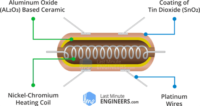
So, the Nickel-Chromium coil and Aluminum Oxide based ceramic forms a Heating System; while Platinum wires and coating of Tin Dioxide forms a Sensing System.
How does a gas sensor work?
When tin dioxide (semiconductor particles) is heated in air at high temperature, oxygen is adsorbed on the surface. In clean air, donor electrons in tin dioxide are attracted toward oxygen which is adsorbed on the surface of the sensing material. This prevents electric current flow.
In the presence of reducing gases, the surface density of adsorbed oxygen decreases as it reacts with the reducing gases. Electrons are then released into the tin dioxide, allowing current to flow freely through the sensor.
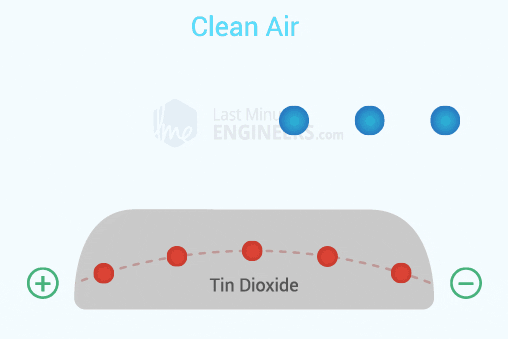
Hardware Overview – (Capteur Gaz MQ2) Gas Sensor Module
Since MQ2 Gas Sensor is not breadboard compatible, we do recommend this handy little breakout board. It’s very easy to use and comes with two different outputs. It not only provides a binary indication of the presence of combustible gases but also an analog representation of their concentration in air.
The analog output voltage provided by the sensor changes in proportional to the concentration of smoke/gas. The greater the gas concentration, the higher is the output voltage; while lesser gas concentration results in low output voltage. The following animation illustrates the relationship between gas concentration and output voltage.
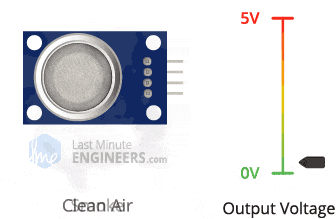
The analog signal from MQ2 Gas sensor is further fed to LM393 High Precision Comparator (soldered on the bottom of the module), of course to digitize the signal. Along with the comparator is a little potentiometer you can turn to adjust the sensitivity of the sensor. You can use it to adjust the concentration of gas at which the sensor detects it.
The sensor is sensitive to multiple gasses – but cannot tell which it is! That’s normal; most gas sensors are like that. So, it is best for measuring changes in a known gas density, not detecting which is changing.
Calibrate MQ2 Gas Sensor Module
To calibrate the gas sensor you can hold the gas sensor near smoke/gas you want to detect and keep turning the potentiometer until the Red LED on the module starts glowing. Turn the screw clockwise to increase sensitivity or anticlockwise to decrease sensitivity.

The comparator on the module continuously checks if the analog pin (A0) has hit the threshold value set by potentiometer. When it crosses the threshold, the digital pin (D0) will go HIGH and signal LED turns on. This setup is very useful when you need to trigger an action when certain threshold is reached. For example, when the smoke crosses a threshold, you can turn on or off a relay or instruct your robot to blow air/sprinkle water. You got the idea!
(Capteur Gaz MQ2) Gas Sensor Module Pinout
Now let’s have a look at the pinout.
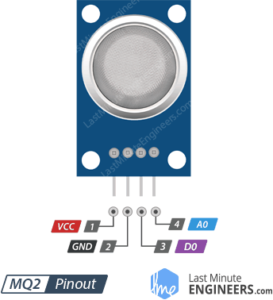
VCC supplies power for the module. You can connect it to 5V output from your Arduino.
GND is the Ground Pin and needs to be connected to GND pin on the Arduino.
D0 provides a digital representation of the presence of combustible gases.
A0 provides analog output voltage in proportional to the concentration of smoke/gas.
Wiring – Connecting (Capteur Gaz MQ2) Gas Sensor Module to Arduino UNO
Now that we have a complete understanding of how MQ2 Gas sensor works, we can begin hooking it up to our Arduino!
Connecting the MQ2 Gas sensor module to the Arduino is pretty easy. Start by placing the sensor on to your breadboard. Connect VCC pin to the 5V pin on the Arduino and connect GND pin to the Ground pin on the Arduino.
Connect D0 output pin on the module to Digital pin#8 on the Arduino and A0 output pin on the module to Analog pin#0 on the Arduino.
When you’re done you should have something that looks similar to the illustration shown below.
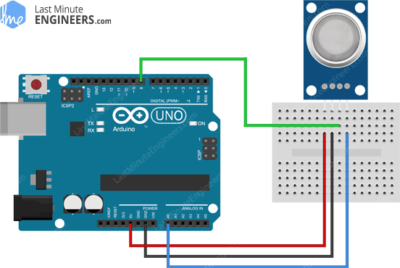
So now that we’ve hooked up our gas sensor it’s time to write some code and test it out.
Arduino Code
The code is very simple & basically just keeps reading analog voltage on A0 pin. It also prints a message on serial monitor when smoke is detected. Try the sketch out, before we begin its detailed breakdown. Plus d’informations visite: **MEGMa**
#define MQ2pin (0)
float sensorValue; //variable to store sensor value
void setup()
{
Serial.begin(9600); // sets the serial port to 9600
Serial.println("Gas sensor warming up!");
delay(20000); // allow the MQ-6 to warm up
}
void loop()
{
sensorValue = analogRead(MQ2pin); // read analog input pin 0
Serial.print("Sensor Value: ");
Serial.print(sensorValue);
if(sensorValue > 300)
{
Serial.print(" | Smoke detected!");
}
Serial.println("");
delay(2000); // wait 2s for next reading
}Code Explanation:
The sketch starts by defining Arduino pin to which analog pin of (Capteur Gaz MQ2) branchement avec Arduino UnoMQ2 gas sensor is connected. A variable called sensorValue is also defined to store sensor value.
#define MQ2pin (0)
float sensorValue; //variable to store sensor valueIn setup function: we initialize serial communications with the PC and wait for 20 seconds to allow sensor to warm up.
Serial.begin(9600); // sets the serial port to 9600
Serial.println("Gas sensor warming up!");
delay(20000); // allow the MQ-6 to warm upIn loop function: the sensor value is read by analogRead() function and displayed on serial monitor.
sensorValue = analogRead(MQ2pin); // read analog input pin 0
Serial.print("Sensor Value: ");
Serial.print(sensorValue);When the gas concentration is high enough, the sensor usually outputs value greater than 300. We can monitor this value using if statement. And when the sensor value exceeds 300, we will display ‘Smoke Detected!’ message.
if(sensorValue > 300)
{
Serial.print(" | Smoke detected!");
}
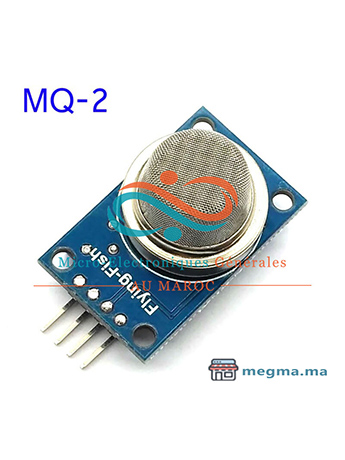
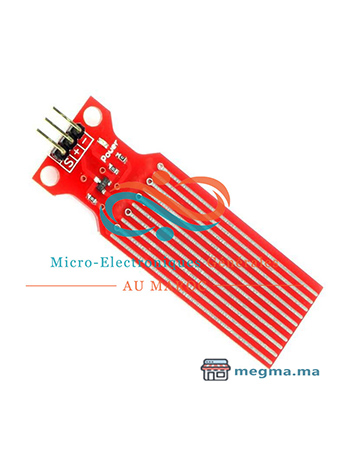


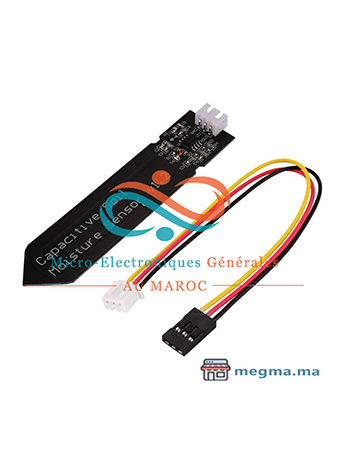
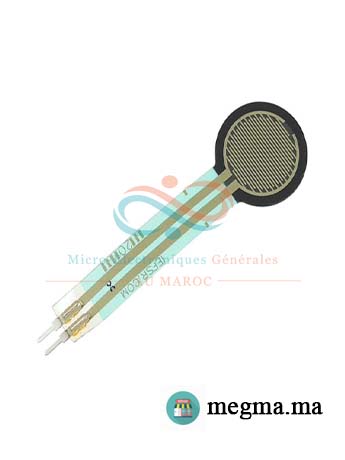
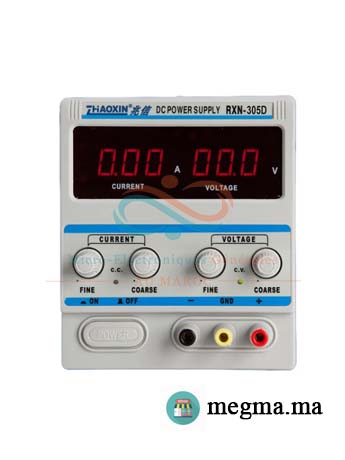
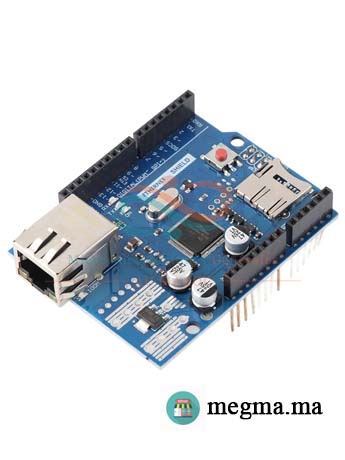

Avis
Il n’y a pas encore d’avis.